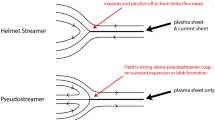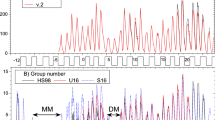Abstract
High-resolution magnetograph observations of the polar magnetic fields have been obtained at intervals of time since the end of 1986 at Big Bear Solar Observatory. The Big Bear data differ from the low-resolution, full-disk magnetograph observations in that the 2 arc sec resolution makes it possible to resolve concentrated field upward of 100 G. The purpose of this ongoing observation is to examine the evolution of polar fields during the expected polarity reversal as cycle 22 passes its maximum phase, and secondly, to study the polar magnetic field: its true field strength, distribution, and how it compares to other parts of the quiet Sun.
We find that the >70° net polar flux of both poles has not reversed as of the end of 1989. However, in the lower latitudes of both poles, 50° to 70°, there are signs reminiscent of those preceding the reversals in cycles 19 and 20. These include: decreasing field intensity in the old polarity fluctuations in net flux between the old and new polarities.
We find that the net average longitudinal polar fields (above 50°) are 1–2 G, in agreement with results found in cycles 19 and 20. For individual elements, however, the strongest observed field strength poleward of 70° is over 100 G.
We compare the polar fields with the equatorial limb as a function of latitute and longitude, respectively, and find the polar fields are comparable to (or stronger than) the quiet equatorial limb. When the observed mean flux density of the polar field as a function of latitude is corrected for limb-darkening and projection effects (assuming the field is radial), the result is nearly constant. These results suggest that despite the high latitudes, the polar fields have field strength and distribution similar to other parts of the quiet Sun.
Similar content being viewed by others
References
Babcock, H. D.: 1959, Astrophys. J. 130, 364.
Babcock, H. W. and Babcock, H. D.: 1955, Astrophys. J. 121, 349.
Howard, R.: 1972, Solar Phys. 25, 5.
Howard, R.: 1974, Solar Phys. 38, 59.
Howard, R.: 1977, Solar Phys. 52, 243.
Howard, R. and LaBonte, B. J.: 1981, Solar Phys. 74, 131.
Makarov, V. I., Fatianov, M. P., and Sivaraman, K. S.: 1983a, Solar Phys. 85, 215.
Makarov, V. I., Fatianov, M. P., and Sivaraman, K. S.: 1983b, Solar Phys. 85, 227.
Mosher, J.: 1976, BBSO special technique report.
Roy, J.-R.: 1977, Solar Phys. 52, 53.
Shi, Z., Wang, J. and Patterson, A.: 1986, BBSO Preprint No. 257.
Tang, F., Howard, R., and Adkins, John M.: 1984, Solar Phys. 91, 75.
Wang, H.: 1988, Solar Phys. 116, 1.
Webb, D. F., Davis, J. M., and McIntosh, P. S.: 1984, Solar Phys. 92, 109.
Zirin, H.: 1985, Australian J. Phys. 38, 961.
Author information
Authors and Affiliations
Rights and permissions
About this article
Cite this article
Tang, F., Wang, H. Polar fields during the rising phase of cycle 22. Sol Phys 132, 247–256 (1991). https://doi.org/10.1007/BF00152286
Received:
Revised:
Issue Date:
DOI: https://doi.org/10.1007/BF00152286




